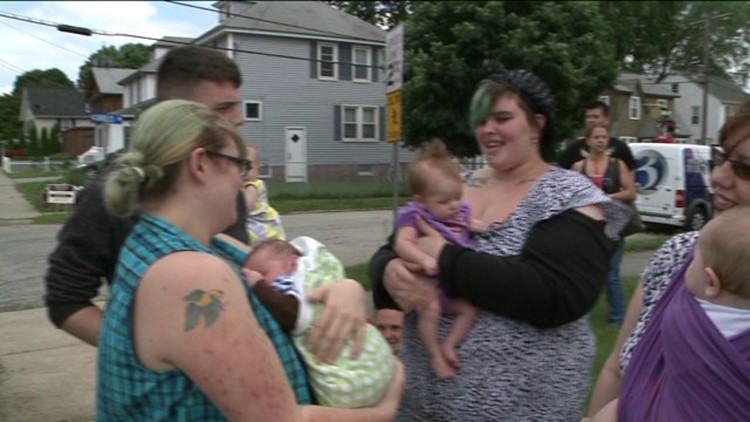BRIDGEPORT, Conn. (AP) — As the leader of a breast-feeding support group, Kathleen Raymond never tries to push new mothers in a certain direction.
Raymond, 38, of Fairfield, sees herself as an educator or a guide through what can be a challenging process for many women.
“When we meet a woman, we don’t have any specific goals in mind for her,” said Raymond who, until recently, led a La Leche League group in Danbury and is starting a new chapter in Fairfield. “We want to know what her goals are, and the best way for her to meet them.”
When a new mom is learning to breast-feed, getting information and support is essential, Raymond said. And, a lot of times, women can’t get that kind of support from their mothers or other female role models, she said, since they most likely raised their children in a culture where breast-feeding wasn’t the norm.
But mother-to-mother support groups such as La Leche are becoming more common — and the rise of technology has made it easier for new moms to find a group that’s right for them.
“I do see more women able to get support,” Raymond said. “I think that’s really helped more women to be successful at breast-feeding.”
The state’s burgeoning network of mother-to-mother support is a key contributor to the rising rate of breast-feeding in Connecticut, experts say.
According to the 2014 Breastfeeding Report Card issued by the U.S. Centers for Disease Control and Prevention, 83.3 percent of babies born in Connecticut start their lives being breast-fed. Connecticut’s rate exceeded the national average of 79.2 percent of babies “ever breast-fed.”
The number of Connecticut babies “ever breast-fed” has increased by 12.3 percent over the past five years, according to CDC data.
However, many advocates and experts said too many women still stop breast-feeding too soon.
The 2014 report card ranks Connecticut higher than the national average for babies still being breast-fed at 6 months (51.4 percent versus 49.4 percent) and for 6-month-old babies nourished exclusively with breast milk (19.2 percent versus 18.8 percent).
“The data is positive and is the result of the work of many programs,” said Dr. Kathleen Marinelli, a neonatologist and member of the Human Milk Research Center at Connecticut Children’s Medical Center.
Experts consider breast-feeding the best source of infant nutrition and immunologic protection. Breast-fed babies are less likely to become overweight and obese, while formula feeding is associated with increases in common childhood infections, such as diarrhea and ear infections. Formula-fed babies face higher risks for major chronic diseases and conditions, including Type 2 diabetes, asthma and obesity.
Breast-feeding helps mothers and babies bond, and lowers the mother’s risk of postpartum depression.
“We know there is a strong connection between breast-feeding and lower risk of breast and ovarian cancer,” said Michele Griswold, chairwoman of the Connecticut Breast-feeding Coalition. “Breast-feeding is not just a children’s issue. Breast-feeding is good for the mother’s long-term health as well.”
There’s the money savings, too. Families can spend $1,200 to $1,500 on infant formula in the first year alone, according to the surgeon general’s report.
“(Breast milk) is species-specific,” said Michele Romano, registered nurse lactation consultant at Greenwich Hospital. “It’s human milk, made for your baby, and you don’t have to purchase a product from a shelf.”
Another major factor helping Connecticut boost its number of breast-fed babies is the Baby-Friendly Hospital Initiative. Established by the World Health Organization and UNICEF, the Baby-Friendly Hospital Initiative is a global program that recognizes hospitals that realign care to promote breast-feeding.
Connecticut ranks second in the nation for births at baby-friendly hospitals, Griswold said. In 2012, 31.1 percent of births in Connecticut occurred in baby-friendly hospitals, according to the state Department of Public Health. Nationally, the rate of baby-friendly hospital births is much lower — only 9.5 percent, Marinelli said.
Hartford Hospital earned its designation as Connecticut’s first baby-friendly hospital in 2000. Since then, seven more hospitals and birthing centers, including St. Vincent’s Hospital in Bridgeport and Griffin Hospital in Derby, joined the list.
St. Vincent’s received the designation in 2010, said Caren Chiarelli, clinical nurse leader at St. Vincent’s Family Birthing Center. She said the program is multi-faceted, encouraging skin-to-skin contact between mother and child and educating mothers about all their options when it comes to feeding their babies.
“If she chooses not to breast-feed, that’s fine, but it’s all about education,” Chiarelli said. “We go through the whole education process with the mother before the baby is even born.”
At Griffin Hospital, which has been baby-friendly since 2012, lactation consultant Michele McGuire said breast-feeding rates at the hospital have increased significantly since it became part of the initiative. Like Chiarelli, McGuire said the program’s goal isn’t to push moms into breast-feeding, but to arm them with information.
“I think it’s important to help our patients who desire to breast-feed to be more successful at it,” she said.
Not all hospitals seek the designation.
Danbury Hospital has “very high breast-feeding initiation rates,” standards established by the World Health Organization and The Joint Commission Prenatal Core Measure Set for breast-feeding.
“Although we promote breast-feeding, and work hard to meet the goals and desires of women who wish to exclusively breast-feed, we felt it more important to support all mothers and fathers in their choice regarding how they wish to feed their infants,” said Maryalice Cullen, director of patient care services, at Danbury Hospital.
Greenwich Hospital also doesn’t have a baby-friendly designation, and Romano agreed that doesn’t mean the hospital is any less committed to supporting new mothers. Romano is also coordinator of Tender Beginnings, Greenwich’s parent education program. The program offers a variety of services, including breast-feeding education classes.
“We’re a mother-friendly hospital,” she said. “We support the mother’s choice.”
Connecticut also outpaces many states in its ratio of professional lactation specialists, the 2014 CDC report card indicates.
In addition, two laws in Connecticut support breast-feeding. The first protects a mother’s right to nurse in places of public accommodation, known as the “breast-feeding in public law,” passed in 1997. The second, which took effect in 2001, mandates all Connecticut employers to allow a mother to “express breast milk or breast-feed on site at her workplace during her meal or break period.”
At least one lactation consultant also credited more support on the national level with encouraging more Connecticut moms to breast-feed. Under the Affordable Care Act, lactation services are fully covered, said Stephanie Cleary, an international board-certified lactation consultant in private practice in Greenwich. That makes a huge difference, she said.
“The government is saying ‘This is important. This is worth it,'” said Cleary, who serves clients in Greenwich, Stamford and other surrounding towns.
But, while more babies born in Connecticut are getting breast milk initially, the number of newborns receiving formula before they are two days old is also increasing, the CDC report shows. In five years, the rate swelled from 18.4 percent to 25.6 percent.
“That’s a scary number — worries a lot of us,” Marinelli said. “What that means is babies are being supplemented with formula in the hospital. A lot of the time, mothers may not even know their babies got formula. A quarter of the babies whose mothers want to breast-feed them are still getting some sort of formula supplementation in the first two days of life.”
Marinelli said the uptick in newborns receiving formula before two days of age is an indication that some of Connecticut’s 28 birthing centers are still not supporting mothers well enough to help them succeed at breast-feeding.
Statistics also show three months after giving birth, more than half of breast-feeding mothers in Connecticut start using formula. By six months postpartum, nearly half give up on breast-feeding.
Griswold added that one concern not highlighted by the CDC statistics is the disparity in breast-feeding rates by race, ethnicity and socioeconomic status. Low-income and minority populations continue to face unique barriers to breast-feeding, she said.
Marla Petrocelli, a board certified lactation consultant and leader of the Bridgeport La Leche League of Connecticut, said women with access to the state-sponsored supplemental nutrition plan for women, infants and children — also known as WIC — become dependent on the formula given out.
Though breast-feeding is on the rise, it still isn’t recognized as the norm for many. Stumbling blocks — from engorgement to embarrassment to societal and family pressures — hinder mothers from nursing their babies long-term. And breast-feeding isn’t always easy. Techniques often need to be taught.
The top reason why women give up on breast-feeding or start supplementing with formula is going back to work, Griswold said.
Petrocelli stressed that the breast-feeding doesn’t have to stop once mothers go back to work
The most important thing is for new mothers to stay informed, either by attending free meetings at local groups like La Leche league, asking their pediatrician for resources or even looking online, Petrocelli said.
Raymond echoed Petrocelli’s thoughts. She said groups such as La Leche are essential in giving mothers the right tools to breast feed successfully.
“I think what we continue to do at La Leche League to just get the information out there,” Raymond said.



